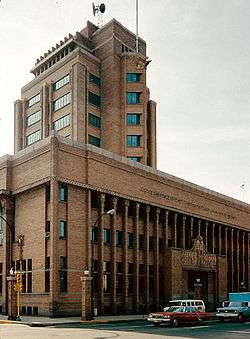William L. Steele

William LaBarthe Steele (May 2, 1875 – March 4, 1949) was an important architect of the Prairie School during the early twentieth century. A graduate of the University of Illinois, Steele worked in the office of renowned architect Louis Sullivan in Chicago, Illinois 1897–1900. He relocated to Pittsburgh, Pennsylvania to gain additional experience with three other architectural firms.
He settled in Sioux City, Iowa in 1904 and did most of his work there, later moving to Omaha, Nebraska in 1929 and beginning a firm with Thomas Rogers Kimball, that eventually became the firm of Steele, Sandham and Steele.[1] Over his career he designed over 250 built commercial buildings, churches, synagogues, homes, schools, and government buildings in Iowa, Nebraska, South Dakota, and Minnesota.
The Woodbury County Courthouse in Sioux City, Iowa is considered his masterpiece, and is arguably the premier example of Prairie School aesthetics in the context of a public space. He collaborated with Minneapolis architects George Grant Elmslie, who was the principal designer, and William Gray Purcell. Like Steele, Purcell had worked briefly for Louis Sullivan, but Elmslie had been Sullivan's chief assistant after Sullivan dismissed Frank Lloyd Wright in 1893 until Elmslie departed in 1909 to join Purcell & Elmslie. The Courthouse is now a National Historic Landmark, as is another of Steele's works, the Walthill Hospital (Walthill, Nebraska, 1912) on the Omaha Indian Reservation, which was later renamed after its founder the Dr. Susan LaFlesche Picotte Memorial Hospital. Over 20 of his surviving works are on the National Register of Historic Places, including the Hartington City Hall and Auditorium (Hartington, Nebraska, 1921-1923).
Steele is one of the founding members of The Nebraska State Board of Examiners for Professional Engineers and Architects (now known as The Nebraska Board of Engineers and Architects). He served on the Board from 1937 until 1962. [2]
| Wikimedia Commons has media related to William L. Steele. |
References
- ↑ "Steele, Sandham And Steele". UNL Historic Buildings. Accessed October 9, 2015. Archived 2015-11-18.
- ↑ https://ea.nebraska.gov/